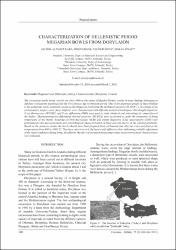| dc.contributor.author | Issı, Ali | |
| dc.contributor.author | Kara, Alpagut | |
| dc.contributor.author | Okyar, Fisun | |
| dc.contributor.author | Sivas, Taciser | |
| dc.contributor.author | Sivas, Hakan | |
| dc.date.accessioned | 2019-10-22T16:58:36Z | |
| dc.date.available | 2019-10-22T16:58:36Z | |
| dc.date.issued | 2011 | |
| dc.identifier.issn | 0862-5468 | |
| dc.identifier.uri | https://hdl.handle.net/11421/21505 | |
| dc.description | WOS: 000293717000007 | en_US |
| dc.description.abstract | The excavation works being carried out since 1989 at Dorylaion (Eskisehir/Turkey) results in many findings belonging to different civilizations spanning from the First Bronze age to Ottoman period. One of the important groups of these findings is the moldmade bowls, familiarly known as the Megarian bowls from the Hellenistic period (330-30 B. C.). In a frame of an archaeometry project work, these artifacts were characterized with different analytical techniques. Wavelength dispersive X-ray fluorescence (WDXRF) and X-ray diffraction (XRD) were used to study chemical and mineralogical composition of the bodies. Thermogravimetric-differential thermal analyses (TG-DTA) were performed to make the estimation of firing temperature of the sherds. Scanning electron microscopy (SEM) and energy dispersive X-ray spectrometry (EDX) were performed for the microstructural and microchemical characterization of body and slip layers of the selected potsherds. Based on the analyses results, the bowls should have been prepared from carbonated and siliceous clays and fired at the temperatures from 600 to 1000 degrees C. They have also iron-rich slip layers with different colors indicating probable adjustment of the redox conditions during firing. In addition, the effect of maximum firing temperature on microstructural characteristics was evaluated. | en_US |
| dc.description.sponsorship | Scientific and Technological Research Council of Turkey (TUBITAK) [106M463] | en_US |
| dc.description.sponsorship | This study was financially supported by the Scientific and Technological Research Council of Turkey (TUBITAK) with the project number of 106M463. | en_US |
| dc.language.iso | eng | en_US |
| dc.publisher | Inst Chemical Technology, Dept Glass Ceramics | en_US |
| dc.rights | info:eu-repo/semantics/openAccess | en_US |
| dc.subject | Megarian Bowl | en_US |
| dc.subject | Hellenistic Pottery | en_US |
| dc.subject | Characterization | en_US |
| dc.subject | Dorylaion | en_US |
| dc.subject | Ceramic | en_US |
| dc.title | Characterization of Hellenistic Period Megarian Bowls From Dorylaion | en_US |
| dc.type | article | en_US |
| dc.relation.journal | Ceramics-Silikaty | en_US |
| dc.contributor.department | Anadolu Üniversitesi, Mühendislik Fakültesi, Malzeme Bilimi ve Mühendisliği Bölümü | en_US |
| dc.identifier.volume | 55 | en_US |
| dc.identifier.issue | 2 | en_US |
| dc.identifier.startpage | 140 | en_US |
| dc.identifier.endpage | 146 | en_US |
| dc.relation.publicationcategory | Makale - Uluslararası Hakemli Dergi - Kurum Öğretim Elemanı | en_US |
| dc.contributor.institutionauthor | Kara, Alpagut | |
| dc.contributor.institutionauthor | Sivas, Taciser | |
| dc.contributor.institutionauthor | Sivas, Hakan | |


















